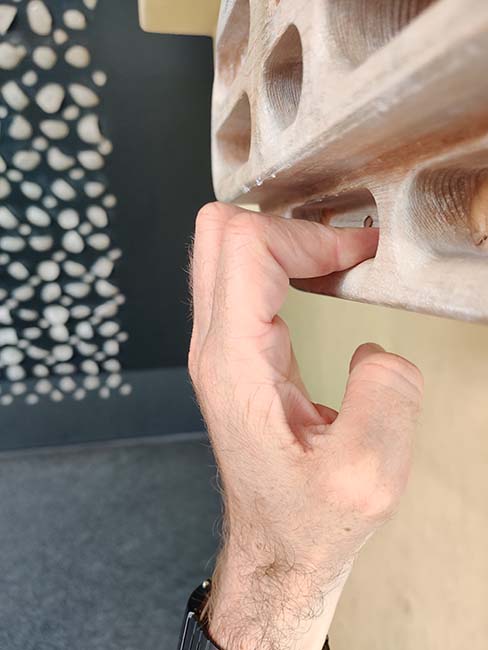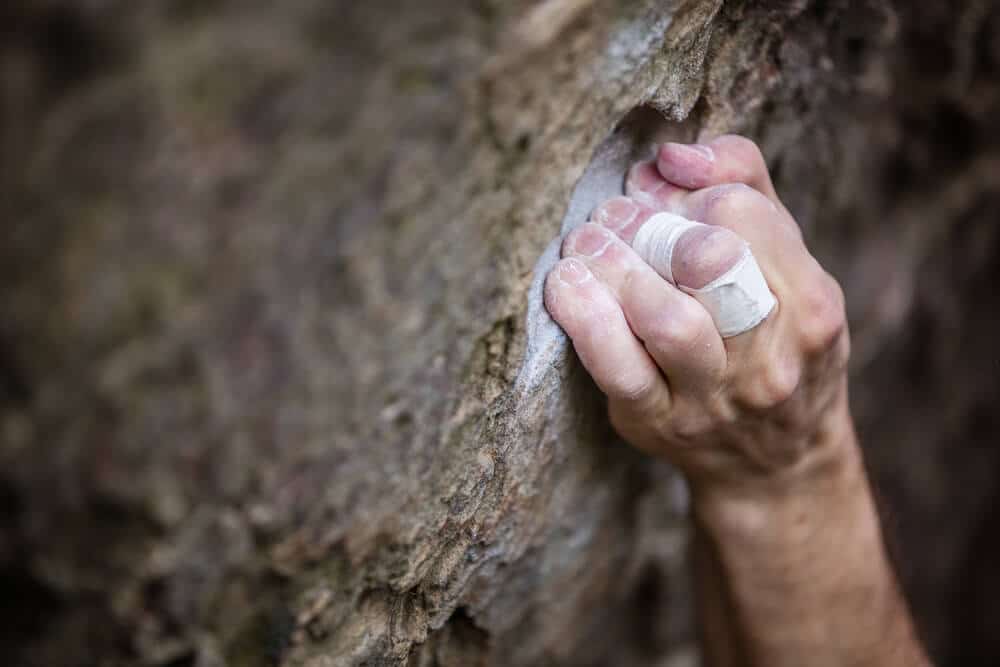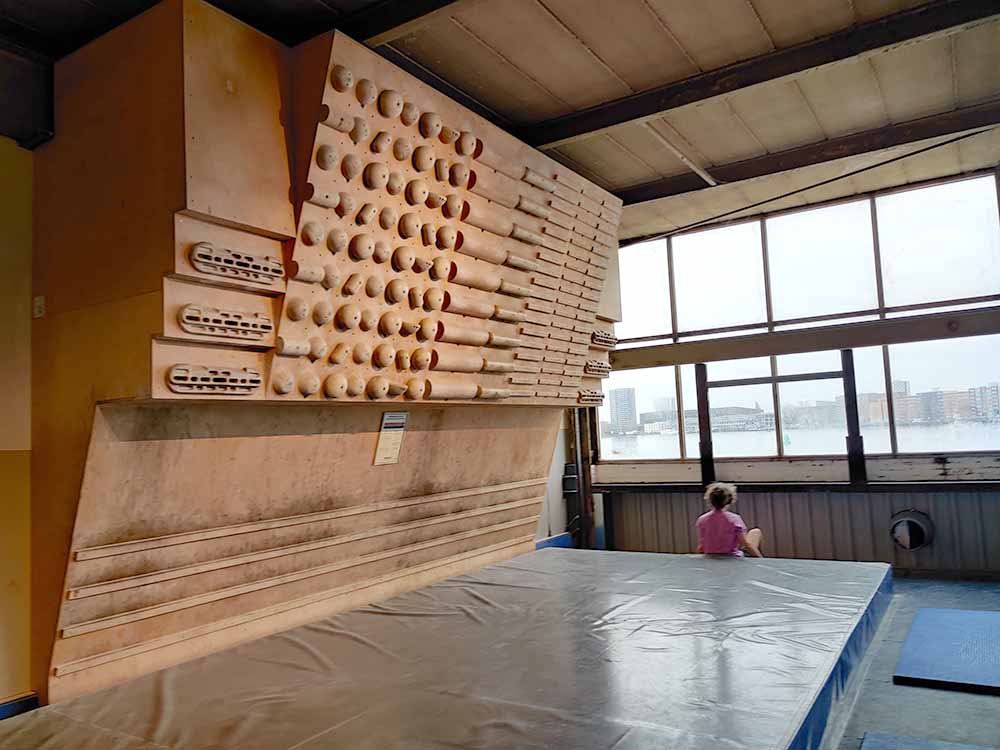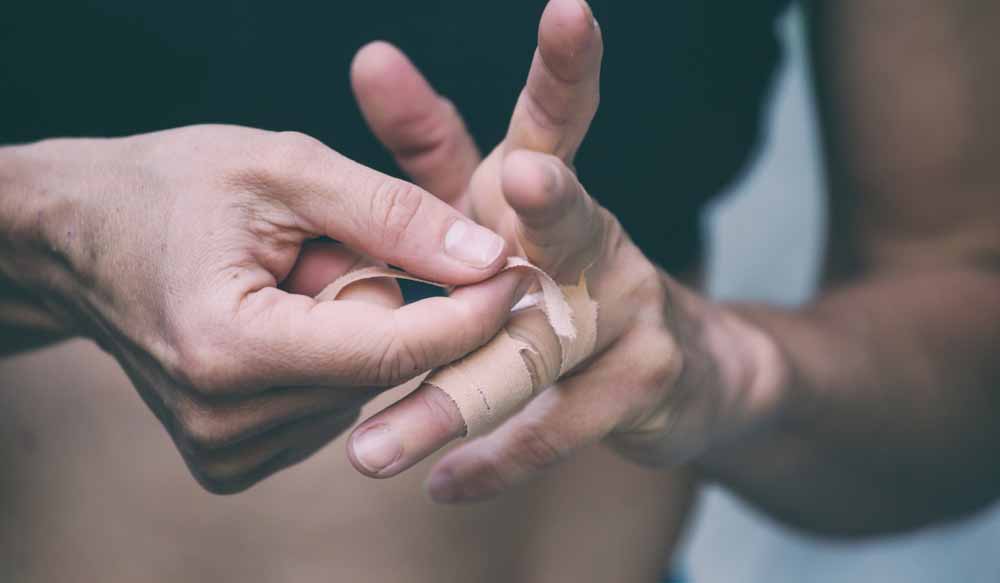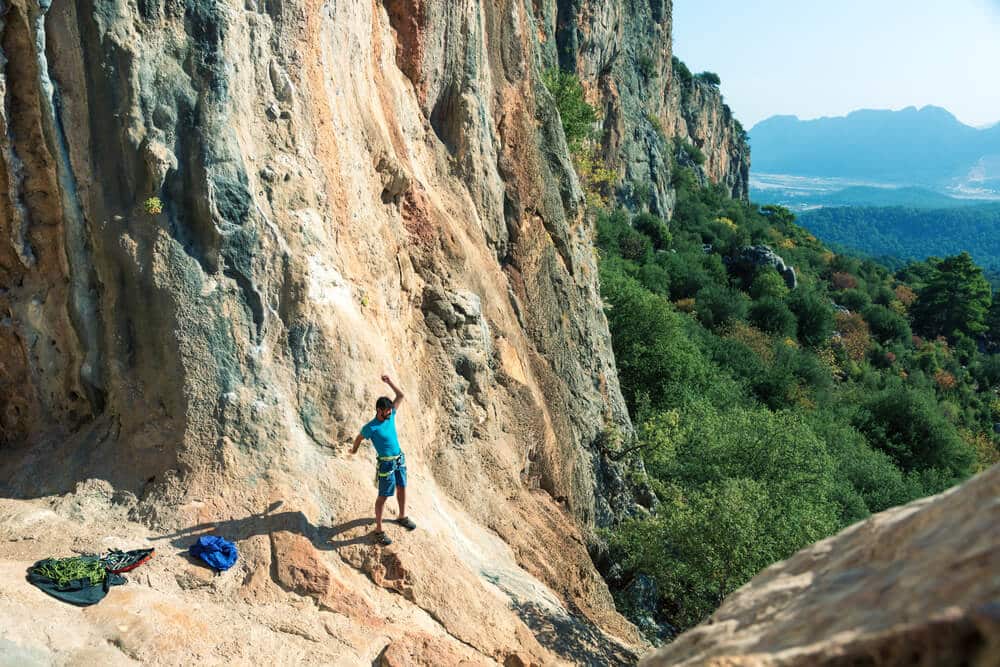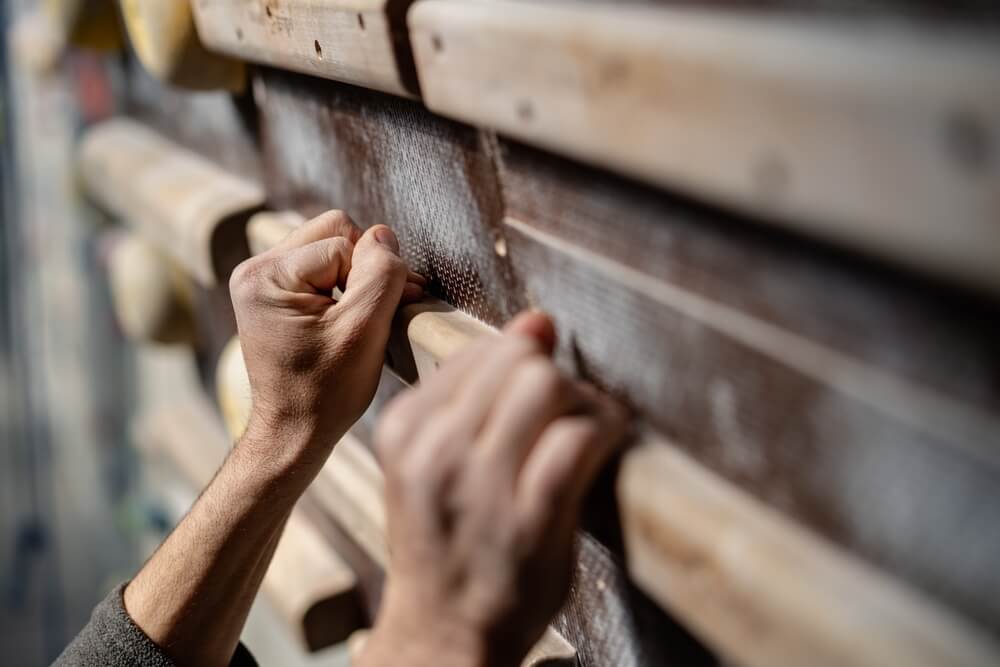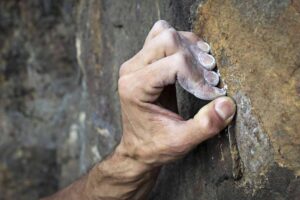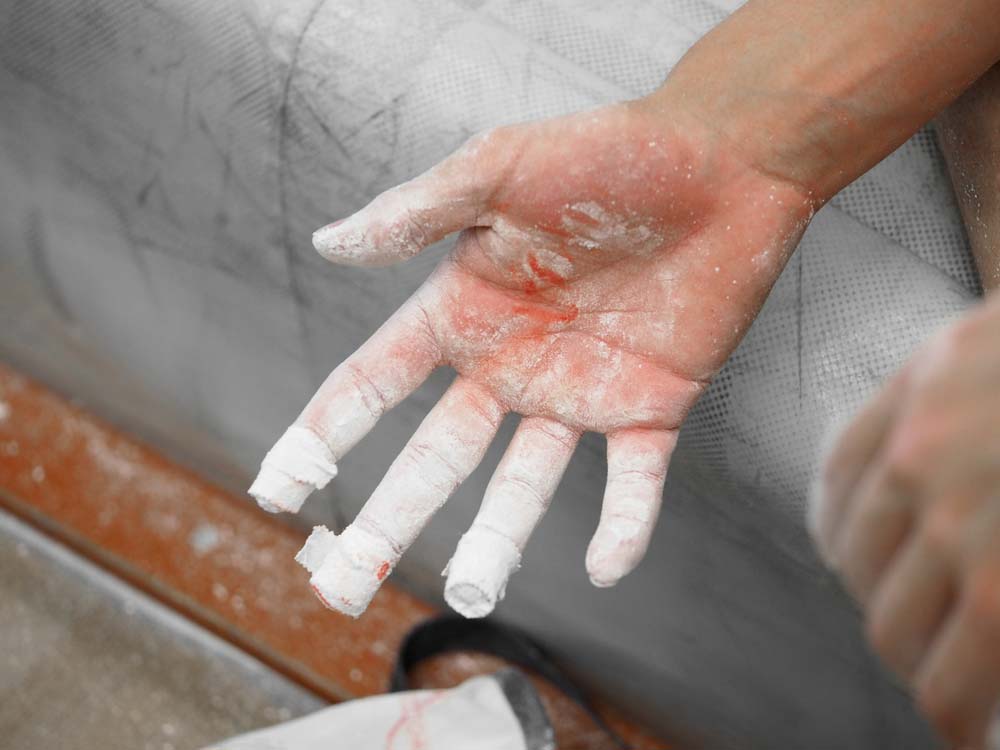Climbing on gigantic, bucket-like jugs, or as I call it, “glory climbing,” is mega fun and makes you feel absolutely heroic. Unfortunately, in rock climbing, one cannot always go glory climbing. A lot of the time, you have to pull hard on narrow edges and other tiny holds that are crappy excuses for climbing holds.
This is especially true as you inevitably get stronger and try harder climbs. That’s why, as a rock climber, being able to manage a variety of crimp grips and deploy various crimping techniques is absolutely essential to your progression.
In this article, I’ll unpack what a crimp is, what the different crimp grips are, how to train crimp strength, and how to avoid injury while doing it.
What is a Crimp? What About Crimping?
The word “crimp” in rock climbing is used as a noun. Specifically, crimp refers to a type of climbing hold. Crimps are small edges, usually one finger pad or smaller, that you grip with your fingertips to climb upwards.
They are found in outdoor climbing and replicated in the climbing gym. Crimps come in all different types of shapes and sizes. They can be sloping or rounded, incut, sharp (i.e., limestone crimps), or rough (i.e., granite crimps).
On the other hand, “crimping” in rock climbing is used as a verb. Crimping refers to the hand position, you deploy with your hands and fingers to grip a climbing hold. More specifically, crimping in climbing is one of many gripping techniques climbers use to hold especially small crimps.
Types of Crimp Grips
When talking about grip positions, “crimp” is actually an umbrella term. Crimp encompasses three different grip types– open hand or half crimp, closed crimp, and full crimp.
Half Crimp or Open-Hand Crimp
The open-hand crimp, also known as the half crimp, is the most widely used type of crimp grip. It’s best for most flat and incut edges, especially if the edges are larger, and can even be deployed on slopers and sloping edges.
In a half crimp, the index, middle, and ring fingers are bent at a 90-degree angle. The pinky may be slightly straighter (because it’s shorter) and slightly gripping the edge of the hold. Meanwhile, the thumb rests next to or underneath the index finger. Or, whenever possible, the thumb is pinching the side of the hold to increase grip.
Closed Crimp
After the half crimp comes the closed-hand crimp. The closed crimp position is different from the half crimp because it adds the thumb into the mix.
In a closed crimp, the index, middle, and ring fingers are bent at a 90-degree angle at the proximal interphalangeal (PIP) joint, or middle knuckle. Meanwhile- the pinky is still slightly straighter. The thumb wraps on top of the index finger, creating a thumb lock.
Closed crimps are effective on small edges where you need extra power to grip the hold.
Full Crimp
The next evolution of the crimp grip is the full crimp. The full crimp looks much like the closed crimp, except with a subtle nuance– hyper-extending the distal interphalangeal (DIP) joints.
In a full crimp, the index, middle, and ring fingers are bent so that the DIP joints hyper-extend inwards. Hyperextension of the DIP joints creates a better angle for creating downward pressure with your fingers bent.
Full crimp grips are the most effective on super thin edges where proper activation of the DIP and PIP joints, plus a thumb lock, is necessary to exert the appropriate pulling power to grip the hold.
How to Train Crimps
Climb Crimpy Routes
When you are getting started climbing, the best way to increase your crimp strength is to stop avoiding crimpy climbs. Instead, you’ll be better off training your weakness, which as a beginner climber, will inevitably be crimping. While trying crimpy routes, it’s important to experiment with different types of crimp grips and hand positions.
Fingerboard Workouts
As you improve your crimp grip and your base level of strength increases, it may be time to start fingerboarding, especially if you are experiencing a training plateau. Fingerboards are one of the most effective tools a climber can use to train the different crimp grips and improve overall forearm strength.
Fingerboards are great because you can replicate the stressors your fingers feel while climbing without going climbing, making fingerboard workouts super potent. On a fingerboard, you can isolate specific crimp grips and train them on different-sized edges in a super-controlled fashion.
Examples of Fingerboard Workouts to Train the Half Crimp Grip
Minimum Edge Protocol
-
Hang for 12 seconds on an edge you can barely hold onto for 15 seconds.
-
Rest for three minutes.
-
Repeat the 12-second hold four more times; each hang should be near the max, but not make you fail.
-
One set is five hangs.
-
Rest for five minutes after each set.
Maximum Weight 10-second hangs
-
Hang for 10 seconds on an edge you can barely hold for 13 seconds. Add or subtract weight as necessary.
-
Rest for three minutes.
-
Repeat the 10-second hold four more times; each hang should be near the max, but not make you fail.
-
One set is five hangs.
-
Rest for five minutes after each set.
Campus Board Sessions
The campus board is another critical tool for training crimp grips. However, it’s a tool best suited for advanced climbers. Over time, as your climbing improves and you build the appropriate amount of strength, campusing with the correct technique and body positioning is one of the best ways to build finger strength. Meanwhile, campusing is also super helpful for training explosive power and contact strength.
Eat a Balanced Diet with Lots of Protein
You can blast your finger tendons and train forearm strength until the cows come home. But if you don’t adequately feed yourself, your body will not be able to rest and recover or adapt to additional changes in your rock climbing training program.
So, if you want to take your crimp grip strength training seriously, you also need to optimize the diet you are eating for rock climbing.
Get lots of Sleep
Sleep is critical for athletic performance. Whether you are training your half-crimp grip or learning to play pickleball, you need to get lots of sleep. When you stop climbing and start sleeping, your heart rests, and your body repairs the muscles and soft tissue (i.e., tendons and ligaments) you abused while trying to hold the tiny crimps on your project.
Common Crimping Mistakes
With every new tool comes the inevitable misuse of the tool. Here are three common mistakes climbers make when it comes to crimp grips.
Crimping Everything
Remember– a crimp is just a singular grip type of many. Therefore, you should not be crimping every hold on your project. This is especially true if you are new to climbing.
Instead of crimping every hold, try to mix in other grip types, like the three-finger drag or half crimp. In addition, if you are certain the only way to hold something is with a super powerful full crimp, consider making adjustments to your feet and body position to make climbing holds feel better instead of always resulting to full crimping.
Not Warming Up
Unfortunately, many climbers (myself included sometimes) do not adequately warm up before climbing hard. Not warming up is a surefire way to get flash pumped, or worse, to expose yourself to injury, especially if the climb you are trying relies on a lot of crimping.
Instead, I encourage you to design a warmup routine that helps loosen up your body and recruit the muscle units you will be using for climbing.
Not Using Chalk
As climbing holds shrink with harder climbs, and as you desperately pull harder to keep your body on the wall, your fingers will inevitably start sweating. Sweaty fingers are okay for easy climbing, but on harder routes with tiny holds, sweaty fingers are your worst enemy.
To combat sweating and keep your fingers dry, use a little bit of climbing chalk. Drier fingers will enhance your gripping power on edges and on open grips while grabbing slopers. Just avoid using copious amounts of chalk because more chalk does not necessarily translate to better performance, and it makes a mess.
Fingerboarding in the Full Crimp Grip Position
Using a fingerboard is a super effective way to build finger strength. However, if you use the fingerboard incorrectly– like full crimping all the edges, all the time– you open yourself up to injury.
Most seasoned climbers and physical therapists will tell you that fingerboarding in the full crimp grip position is unnecessary for most climbers to build reliable finger strength, especially beginner and intermediate-level climbers.
How to Avoid Finger Injuries from Crimping
Crimping comes with a lot of baggage– especially the full crimp. What I mean by that is that crimp grips, in particular the full crimp, are notorious for causing finger injuries. That’s because the force you exert on your joints and tendons while crimping a small edge is extremely stressful.
For that reason, it is vital to train your crimp grip strength slowly and methodically throughout your climbing career, allowing your body to adapt and strengthen, and rest and recover when necessary.
-
Let Your Body Adapt to Crimping- if you are new to climbing, you should not be fully crimping. That’s because the connective tissues in your fingers need a lot more time to adapt to to new grip and hand positions.
-
Allow Time for Rest and Recovery- the bottom line is that connective tissue does not recover quickly or heal fast after injury. So, if you are climbing super hard and training five times a week, you may need to consider adjusting your training frequency to prevent injuries.
-
Avoid Repetive Crimp Climbing-projecting a route or crimpy boulder problem can be fun. But if you notice the quality of your efforts is diminishing, consider taking a rest. Wait at least six to seven minutes minutes and then try again. If the rest doesn’t help and your effort is still sub-par, you should be done to avoid injuring your fingers.
Final Thoughts – The more you can deploy different crimp grips, the better
It’s common for climbers to develop favorites when it comes to the three different types of crimps. This means that oftentimes, one hand position becomes stronger than the others. For example, my strongest crimp grip is closed crimp.
Developing preferences is normal– however, to be a well-rounded climber and manage the myriad holds you encounter outside and in the climbing gym, training all the grip types to the best of your ability will help you progress faster than only specializing in a single one.
Use the fingerboard (and when you are ready, start campusing), eat a balanced diet, and allow your body to rest and recover. Meanwhile, avoid the pitfalls that cause chronic finger injuries, and you’ll be thrilled with your progression.



